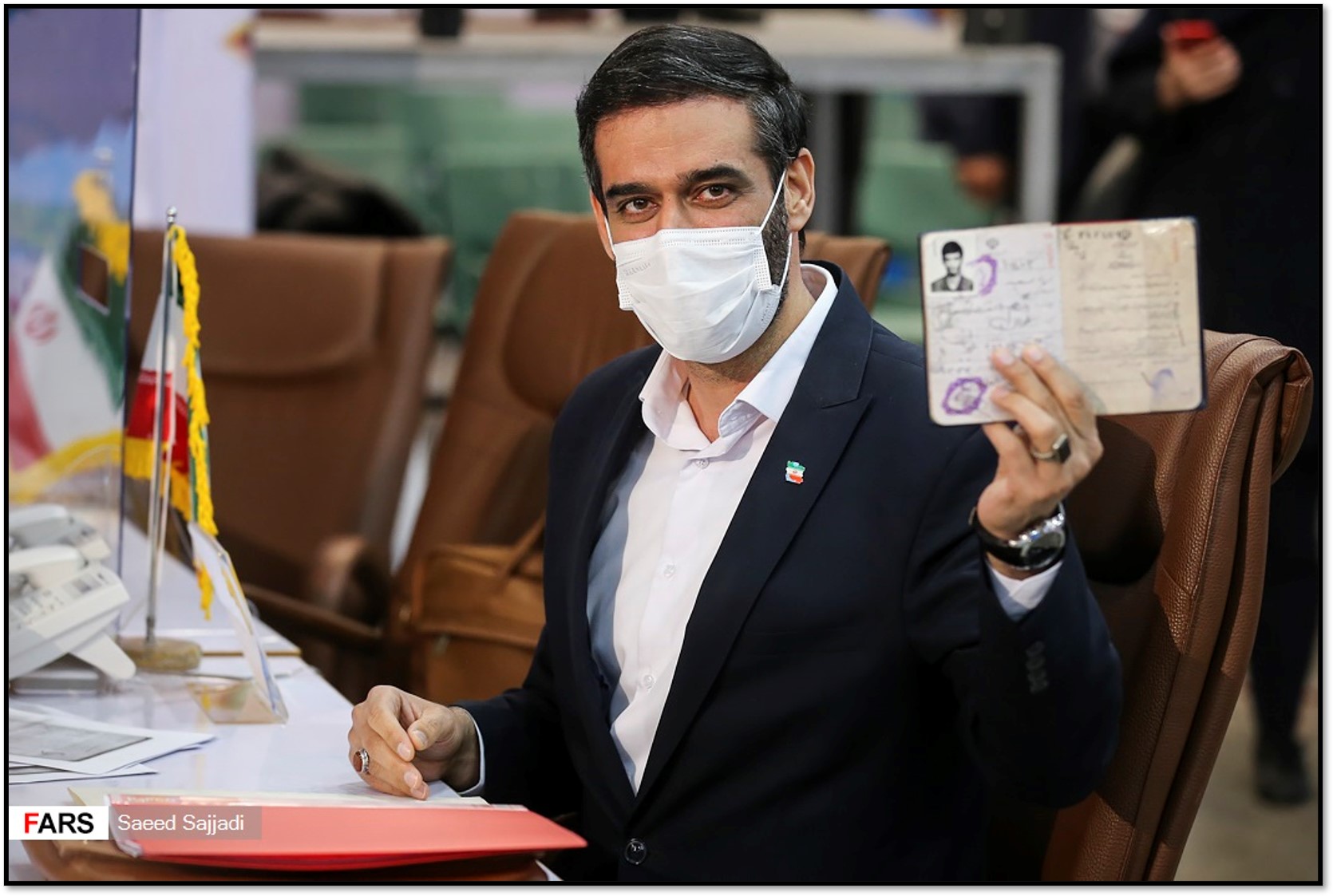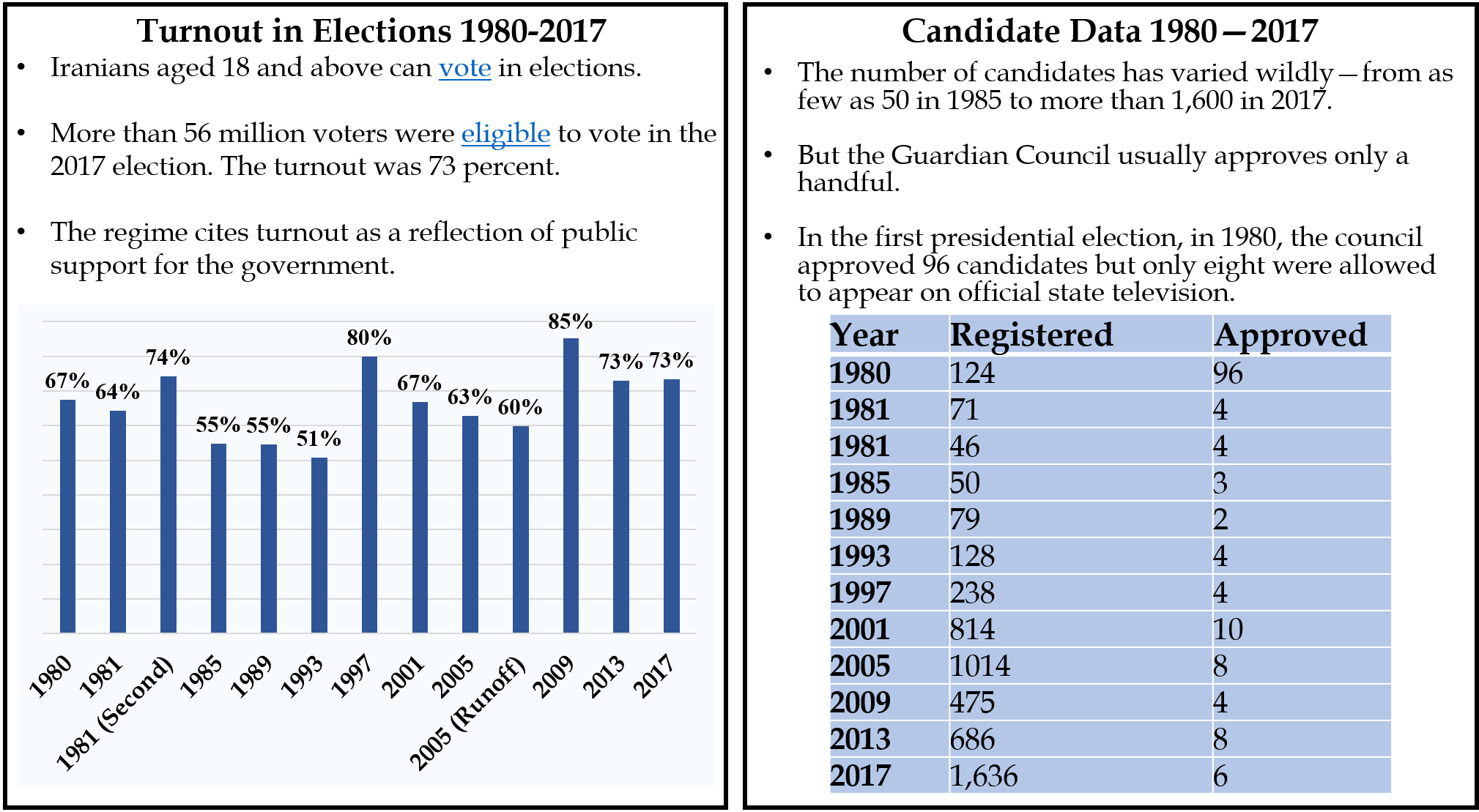Iran’s presidential election is scheduled for June 18. Registration for candidates began on May 11, and seven candidates were selected to run on May 25. The poll will be pivotal to Iran's future since President Hassan Rouhani cannot run again; the Islamic Republic has a limit of two consecutive terms. The next president will set policy on both foreign relations, including diplomacy on Iran's nuclear program, and domestic affairs at a time of crisis due to economic sanctions as well as the COVID-19 pandemic.

In Iran, the presidency has often flipped between reformists or centrists and conservatives or principlists. The reformists have promised an array of social openings, press freedoms and accountability on human rights. They emphasize that the Islamic Republic of Iran is first and foremost a republic in which Islam is to be a guide and a check on the traditional institutions of power. Hardliners generally adhere to the rigid dogma of the 1979 revolution and argue that the supreme leader and God's law are the ultimate power. President Mohammad Khatami (1997-2005) is viewed as the most reformist president, while Mahmoud Ahmadinejad (2005-2013) is viewed as the most hardline. President Hassan Rouhani (2013-2021) is considered a centrist allied with the reformist faction.
On May 11, Supreme Leader Ayatollah Ali Khamenei said that the next government could benefit from harnessing the power of Iran’s youth. “The youth has all the requirements of a movement towards development, which are new thinking, creativity, strength and courage to act,” he said in an address to students. “Transformation is necessary.” Khamenei called for a “young revolutionary government” made up of experienced statesmen as well as youth. The supreme leader expressed public support for the list of candidates selected by the Guardian Council and called for high voter turnout. "Dear nation of Iran, do not pay attention to those who promote that voting is useless," he said on June 27.
There is widespread speculation both inside Iran and among experts abroad that the next president may be more conservative than Rouhani. The 2021 election was also be distinguished by the number of veterans from the Islamic Revolutionary Guard Corps (IRGC) contending for the presidency. The powerful Guardian Council – an unelected panel of 12 Islamic jurists and scholars – approved the final list of candidates. In the 2020 parliamentary election, it disqualified 7,296 candidates out of the more than 14,500 who registered to run. The vetting prevented reformists, including incumbents, from fielding candidates for 230 out of parliament’s 290 seats. The following is a rundown of the candidates, elections rules, and schedule as election season begins.
Election Schedule
- May 11-15: Candidates register to run with the Ministry of Interior.
- May 16-20: The Guardian Council reviews the candidates’ qualifications.
- May 20-25: The Guardian Council fields appeals from disqualified candidates.
- May 27 (or earlier): The Guardian Council announces a list of approved candidates. Historically, 10 candidates or less have been qualified.
- June: Televised presidential debates.
- June 16: Official campaigning ends 24 hours before the polls open, so June 16 is the final full day of campaigning for the candidates.
- June 18: Iranians vote for president and all local councils, and to fill four seats on the Assembly of Experts charged with appointing and, potentially, dismissing the supreme leader. Voters in six districts vote for empty seats in parliament. Polls close at 2:00 A.M. on June 19. More than 59 million Iranians are eligible to vote in the 2021 election.
Candidates
On May 25, Iran approved seven candidates to run for president. A total of 592 candidates, 552 men and 40 women, had registered to run. The Guardian Council said that only 40 men met the basic qualifications. The council whittled the list down to seven candidates – less than two percent of those who registered. It included five conservatives, one centrist and one reformist:

- Amir Hossein Ghazizadeh Hashemi: Four-term member of Parliament (2008 to present) representing Mashhad and Kalat district. A hardliner.
- Abdolnaser Hemmati: Former governor of the Central Bank of Iran (2018 to 2021) and a former vice president of Islamic Republic of Iran Broadcasting. A political centrist.
- Saeed Jalili: Member of the Supreme National Security Council (secretary from 2007 to 2013; supreme leader’s representative from 2014 to present), a former nuclear negotiator during the Ahmadinejad presidency (2007 to 2013), and a veteran of the Iran-Iraq War. A hardliner.
- Mohsen Mehralizadeh: Former governor of Isfahan province (2017 to unknown), former vice president under President Mohammad Khatami (2001 to 2005), and a former Revolutionary Guards commander. A reformist.
- Ebrahim Raisi: Judiciary chief (2019 to present), presidential candidate in 2017, deputy chief of the Assembly of Experts (2019 to present), and former prosecutor general. A hardliner.
- Mohsen Rezaei: Secretary of the Expediency Council, presidential candidate in 2005, 2009, and 2013 and a former Revolutionary Guards commander-in-chief. A hardliner
- Alireza Zakani: Member of parliament (from 2004 to 2016 and from 2020 to the present), medical doctor and a veteran of the Iran-Iraq War. He was twice disqualified from running in 2013 and 2017. A hardliner.
The Guardian Council barred at least four experienced politicians; three had been cleared to run in previous elections. They included:
- Ali Larijani: a conservative who was speaker of parliament from 2008 to 2020. He was cleared to run in 2005.
- Eshaq Jahangiri: Vice President under President Hassan Rouhani since 2013. He was cleared to run in 2017.
- Mahmoud Ahmadinejad: Former President from 2005 to 2013. He was also barred in 2017.
- Mohsen Hashemi: Chairman of the City Council of Tehran since 2017 and son of former President Hashemi Rafsanjani.
Qualifications to Run
Piety and background: Article 115 of the constitution stipulates the qualifications for presidential candidates: “The President must be elected from among religious and political personalities possessing the following qualifications: Iranian origin; Iranian nationality; administrative capacity and resourcefulness; a good past-record; trustworthiness and piety; convinced belief in the fundamental principles of the Islamic Republic of Iran and the official religion of the country.”
Gender: The constitution does not specify a gender for the presidency. The Guardian Council has never cited gender as grounds for disqualification, although it has never qualified a female candidate. The first woman to register to run, in 1997, was Azam Taleghani, a women’s rights advocate and the daughter of a prominent revolutionary cleric. Women have continued to register in increasing numbers. In 2017, a record number of women—137– registered. In September 2020, Abbas-Ali Kadkhodaei, a Guardian Council spokesman, said that there was no legal prohibition against a woman president. But he added that the body had also not yet ruled on how to interpret the article—or the word rejal, which comes from the Arabic word for men but could also mean “personalities.”
Age and education: On May 6, 2021, the Guardian Council issued new requirements, which were endorsed by 200 members of parliament but challenged by Rouhani, who argued that the Guardian Council lacked the legal authority to add criteria. The new requirements included:
- Be between ages 40 and 75
- Hold a master’s degree or equivalent
- Have four years of managerial experience
The president must receive more than half the vote. If no candidate wins more than 50 percent, the two top candidates compete in a runoff. Since the 1979 revolution, Iran has only had one runoff. In 2005, Ali Akbar Hashemi Rafsanjani won 21 percent and Mahmoud Ahmadinejad won 19 percent. Ahmadinejad won in the runoff with 62 percent of the vote.
Data on Past Elections

Photo Credits: Fars News Agency (CC BY 4.0); Tasnim News Agency (CC BY 4.0)
